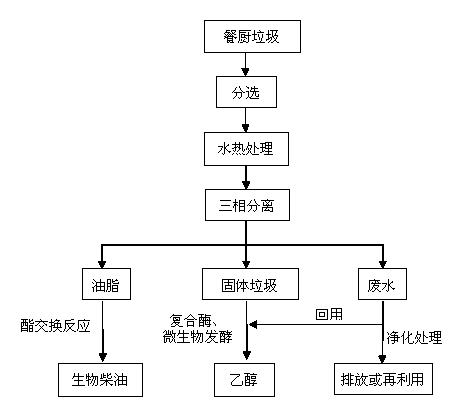Method for improving alcohol output of kitchen waste by hydrothermal pretreatment
A technology for food waste and hydrothermal treatment, applied in the direction of microorganism-based methods, biochemical equipment and methods, microorganisms, etc., can solve the problems of complex composition of biological bacteria liquid and mixed enzyme preparation, difficult acquisition of bacteria, cumbersome configuration methods, etc. , to achieve good application value, low production cost and high raw material utilization
- Summary
- Abstract
- Description
- Claims
- Application Information
AI Technical Summary
Problems solved by technology
Method used
Image
Examples
Embodiment 1
[0034] 1. Preliminarily sort the collected food waste, remove the sundries that are not easy to ferment, put it into the hydrothermal reactor, add 1 times the volume of water, and conduct hydrothermal treatment at 140°C for 50 minutes, during which time, turn on the motor to stir for 20 minutes.
[0035] 2. After the hydrothermal treatment, the kitchen waste is sprayed into the three-phase separator, and the grease is separated after standing.
[0036]3, water and solid are sent to fermentation tank, add the composite enzyme of 0.5% of solid weight, the mass ratio of various enzymes in composite enzyme is amylase: cellulase: lipase: protease: glucoamylase: xylanase= 2:0.8:0.6:1.3:1:2.5. The composition of the enzyme preparation is: amylase (200000u / g), cellulase (200000u / g), lipase (200000u / g), protease (200000u / g), glucoamylase (100000u / g), xylanase (100000u / g). Then add 10% composite flora of solid weight, and ferment for 96 hours at 32°C. The ratio of each species in the...
Embodiment 2
[0038] The main steps of this embodiment are the same as in Example 1, the difference is that in step 1, when the food waste contains more water, after preliminary sorting to remove impurities that are not easy to ferment, it is directly hydrothermally treated at 200°C for 10 minutes, and at the same time Do not turn on the stirring motor. After the hydrothermal treatment, the pressure is released. When the pressure of the hydrothermal reactor is released to 1.3atm, the kitchen waste is sprayed into the three-phase separator, and after standing still, the oil and the water exceeding the solid-liquid ratio range required for ethanol fermentation are separated. The remaining solids and water were sent to the fermenter, and 0.05% of the solid weight of the compound enzyme and 35% of the solid weight of the mixed flora were added, and fermented at 35°C for 130 hours.
Embodiment 3
[0040] The main steps of this embodiment are the same as in Example 1, the difference is that in step 3, the kitchen waste water stored in three-phase separation is added so that the solid-liquid volume ratio is 1:6, and then 2% of the solid weight of the compound enzyme and the solid weight are added 0.3% of the complex flora. Wherein, the mass ratio of each enzyme in the compound enzyme is amylase: cellulase: lipase: protease: glucoamylase: xylanase=0.5:5:1:2:2:1. The ratio of each bacterial species in the composite flora is Kluyveromyces: Saccharomyces cerevisiae: Pseudomonas saccharophila: Bacillus subtilis: Aspergillus niger: Rhizopus oryzae: Trichoderma konii: Mucorella ruckeri=7: 1:5:1:1:6:1:1. Fermentation was carried out at 43°C for 96 hours.
PUM
 Login to View More
Login to View More Abstract
Description
Claims
Application Information
 Login to View More
Login to View More - R&D
- Intellectual Property
- Life Sciences
- Materials
- Tech Scout
- Unparalleled Data Quality
- Higher Quality Content
- 60% Fewer Hallucinations
Browse by: Latest US Patents, China's latest patents, Technical Efficacy Thesaurus, Application Domain, Technology Topic, Popular Technical Reports.
© 2025 PatSnap. All rights reserved.Legal|Privacy policy|Modern Slavery Act Transparency Statement|Sitemap|About US| Contact US: help@patsnap.com

